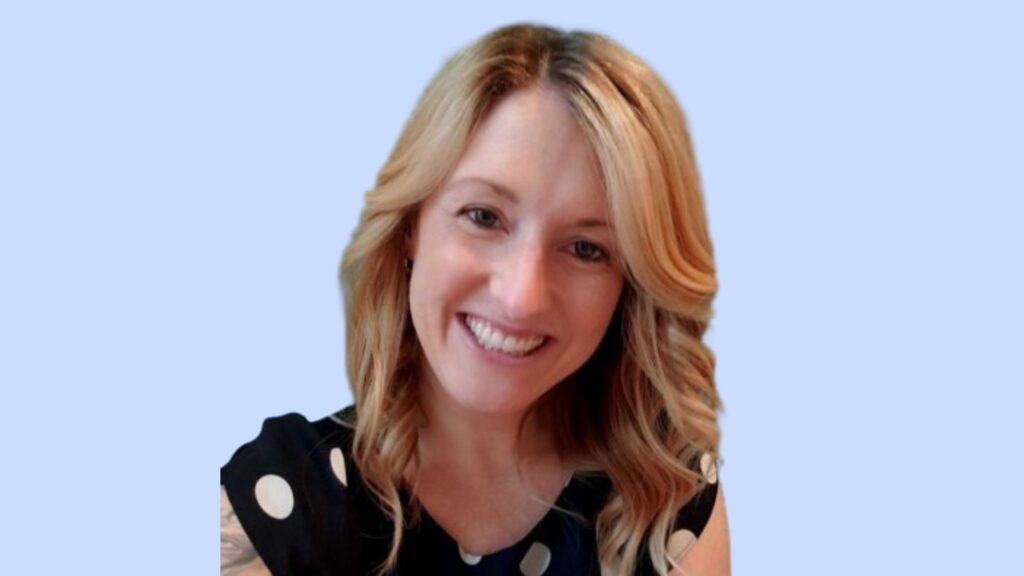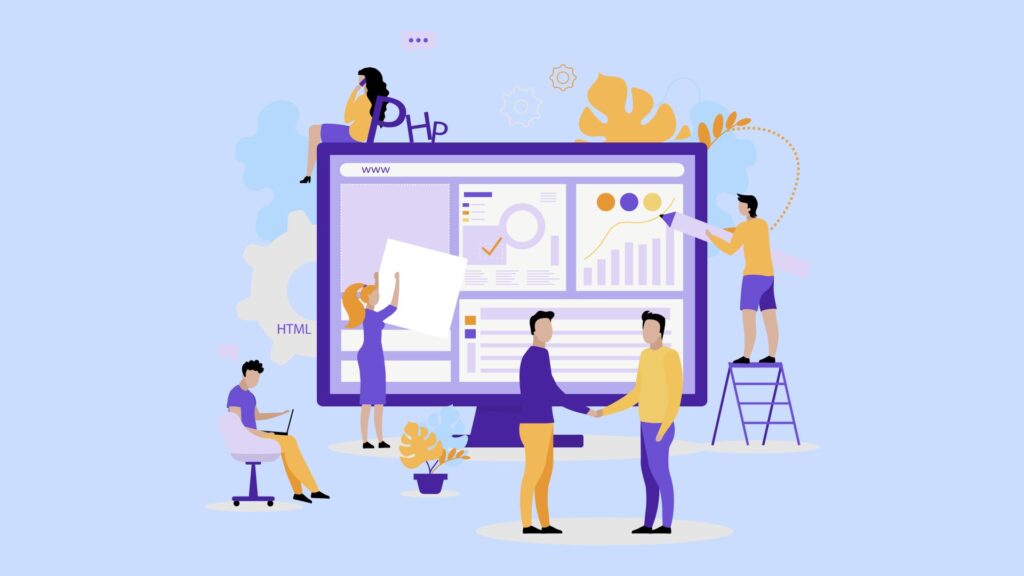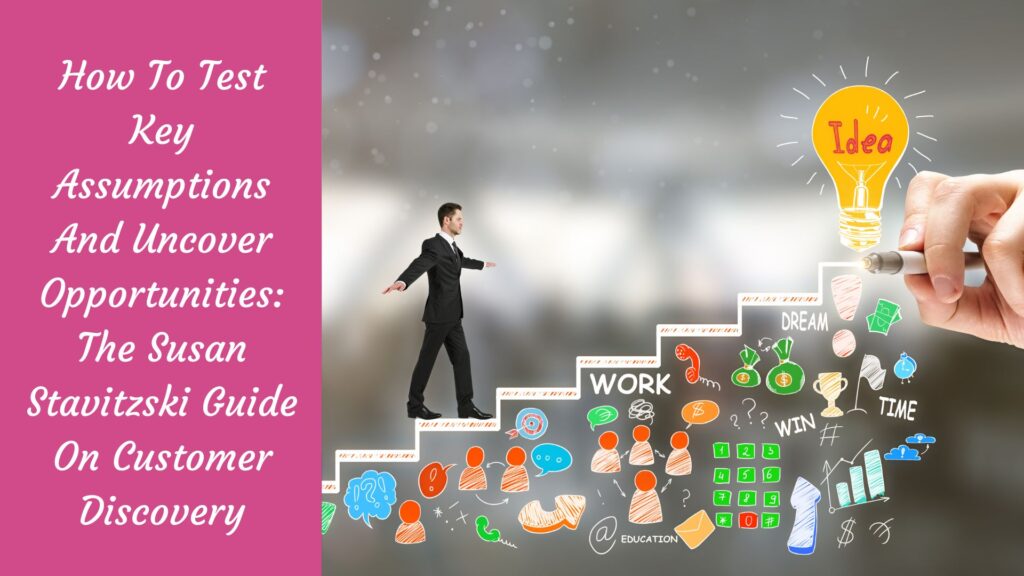In today’s fast-paced market, truly understanding your audience can feel like a puzzle. Without knowing what your customers really want, launching products can lead to costly misses rather than hits.
This is where the power of Customer Discovery steps in, making sure you’re not just throwing ideas into the void.
Our blog post offers a step-by-step guide inspired by Susan Stavitzski’s effective strategies to not only test your key assumptions but also unearth new opportunities.
Stay tuned to learn how to align your offerings with your customers’ actual needs, ensuring your next product launch is a resounding success.
The Foundation of Customer Discovery

The foundation of customer discovery lies in the quest to deeply understand your customers – not just who they are, but what they need, what problems they’re facing, and how your product can solve those problems. At its core, the customer discovery process is a strategic approach to ensure that your product idea isn’t just a shot in the dark; it’s something that will genuinely resonate with your target market.
What Customer Discovery Is: In plain terms, customer discovery involves getting out of the building (literally or figuratively) and talking to your potential customers. It’s about asking open-ended questions, listening to their feedback, and understanding their pain points. This step is critical because it helps you to:
- Test your assumptions about who your customers are.
- Learn what features they really need in your product.
- Understand how your product fits into their lives or businesses.
Why It’s Important: Think of customer discovery as the compass for your product development pathway. Without it, you’re navigating blind. With it, you’re able to make informed decisions that lead to the creation of a product people actually want. The importance of this process can’t be overstated because it:
- Reduces the risk of product failure.
- Helps you pivot quickly if your initial assumptions are wrong.
- Saves time and money by focusing on what customers genuinely need.
Validating Product-Market Fit: In the context of product development, product-market fit means creating a product that meets the needs of your target market in a way that stands out from the competition. Customer discovery is the first step in achieving this fit. By engaging with potential customers early on, you can:
- Verify if there’s a demand for your product.
- Tailor your product’s features to meet the specific needs of your target market.
- Adjust your marketing strategy to address the real concerns and desires of your customers.
Integrating customer discovery into the early stages of your product development process can lead to game-changing insights. By rigorously testing your assumptions and engaging directly with your target market, you’re not just guessing what your customers might want; you’re actively learning and adapting to meet their actual needs. This approach not only validates your product-market fit but also positions your product for greater success in the competitive market landscape.
Who is Susan Stavitzski?

Susan Stavitzski isn’t just a name in the world of product management and customer discovery; she’s a trailblazer. With over two decades under her belt, Susan has meticulously sculpted her career into one that many in the industry look up to. Her journey isn’t just about climbing the corporate ladder; it’s about fundamentally changing how companies interact with their customers to create products that don’t just sell but also solve real problems.
- A Pioneer in Customer Discovery: Early in her career, Susan recognized a gap that many failed to see—the lack of real, deep understanding between businesses and their customers. She championed the cause of getting “out of the building” to speak with real people about their needs, fears, and desires. This wasn’t just chit-chat; it was a structured way to unearth the goldmine of insights that customers hold. She introduced innovative customer discovery practices that many startups and established companies have since adopted.
- Contributions to Product Management: Susan’s impact on product management can be seen in her methodology, which places the customer at the heart of the product development process. She played a key role in shifting the focus from what companies believed was right to what customers actually needed, evidenced by her work with multiple Fortune 500 companies. These companies, under her guidance, saw notable increases in customer satisfaction and product market fit.
- Her Philosophy: Susan’s philosophy is simple yet profound—listen more than you speak. According to her, the key to uncovering opportunities and ensuring product success lies in understanding the customer so well that the product practically shapes itself around their needs. This mantra has guided her approach to customer discovery, advocating for a process where feedback drives innovation. It’s not just about finding out if people would use your product but discovering how to make your product truly indispensable to them.
Susan Stavitzski’s approach has inspired many within the tech industry to pivot towards a more customer-centric model of product development. By emphasizing the importance of customer discovery, she has contributed not just to the success of numerous products but also to a shift in how product development is perceived—a shift where understanding and meeting customer needs is paramount.
Her insights into the power of customer feedback in uncovering hidden opportunities have made her a sought-after speaker and advisor in the field.
Key Assumptions in Product Development

In the world of product development, a key assumption is pretty much a guess or belief you have about your product and the market it’s going into. It’s like thinking, “People are definitely gonna wanna use my app because it solves this big problem.” But here’s the thing: if you don’t test these guesses out, you might end up building something that no one really wants or needs. Untested assumptions are like walking blindfolded; you might hit the target, but chances are, you’ll miss.
For example, many product teams make assumptions like:
- “Our target audience will find this feature super useful.” But maybe that feature isn’t as crucial to your audience as you think.
- “People will pay X amount for our product.” When, in reality, your price point might be way off from what folks are willing to shell out.
- “We’ll easily grab a big chunk of the market share.” Without considering the current competition and market saturation.
The Stavitzski Method for Testing Assumptions
Now, let’s move on to the Stavitzski Method for testing these assumptions. Susan Stavitzski’s way of doing things boils down to getting out there and actually talking to your potential customers. Here’s how you apply her methods:
- Identify Your Key Assumptions: Write down all the big guesses you’re making about your product, market, and customers.
- Create Simple Experiments: For each assumption, figure out a quick, low-cost way to test it. For example, if you think people will pay X amount for your product, set up a landing page where folks can pre-order at that price.
- Talk to Real People: This is the heart of the Stavitzski Method. Get out of your office and have real conversations with potential customers. Use surveys, interviews, or even informal chats to get their thoughts.
- Analyze & Act: Look at the data and feedback you gather. Does it support your assumptions? If yes, awesome. If not, it’s time to pivot or tweak your approach.
Following the Stavitzski Method means you’re not just shooting in the dark. You’re making informed decisions based on what real people have told you, which drastically increases your chances of hitting that bullseye with your product.
Tools and Techniques for Effective Customer Discovery

Susan Stavitzski, a pioneer in the product management realm, has introduced a plethora of tools and techniques to make customer discovery insightful and actionable. Here are some of the top tools and methodologies she recommends, along with how to leverage them effectively.
Engaging with Your Audience
- Interviews: One-on-one conversations can unveil a goldmine of insights. Susan suggests structuring these interviews with open-ended questions to encourage detailed responses. For instance, instead of asking if they like your app, ask how they currently solve the problem your app addresses.
- Surveys: When face-to-face interviews aren’t feasible, surveys come in handy. Tools like SurveyMonkey or Google Forms can help collect quantitative data. Tip: Keep surveys short and sweet to boost completion rates.
- Observation: Sometimes, actions speak louder than words. Observing potential customers using a competitor’s product or performing tasks your product aims to simplify can provide invaluable insights. Leveraging technology, such as screen recording sessions, can aid in this aspect of customer discovery.
Incorporating these techniques helps in leveraging technology in customer discovery and conducting effective customer interviews. By directly engaging with your audience, you gain a deeper understanding of their needs and pain points.
Data-Driven Customer Discovery
Understanding the customer’s voice through data is key to validating your product’s assumptions. Here’s how you can utilize data to your advantage:
- Analyzing Feedback: Tools like Qualtrics and Zendesk can help analyze feedback from surveys and support tickets, respectively. This data can provide a real-time pulse on customer satisfaction and pain points.
- Behavioral Data: Analytics platforms such as Google Analytics or Mixpanel enable you to understand how users interact with your product. Monitor which features are most used and identify where users drop off.
- Case Studies: Take Dropbox, for example. They utilized data from their beta testing phase to understand how users interacted with their file-sharing service. This direct feedback loop allowed them to prioritize features that users found most valuable, significantly contributing to their product-market fit.
Leveraging these data-driven approaches allows for a more strategic understanding of customer needs and behaviors, ultimately guiding better product decisions.
By combining direct engagement with sophisticated data analysis, product teams can uncover deep insights that drive innovation and ensure that their products resonate with their target audience. Susan Stavitzski’s methodologies underscore the importance of a holistic approach to customer discovery, proving that understanding the customer is the foundation of product success.
Navigating Challenges in Customer Discovery

Navigating challenges during the customer discovery process can sometimes feel like you’re trying to solve a puzzle with missing pieces. But, with some insider know-how from Susan Stavitzski’s approach, you can turn those obstacles into opportunities. Here’s how:
Common Obstacles:
- Lack of Engagement: Sometimes, potential customers are just not that into sharing feedback. Maybe they’re busy, or maybe they’re just not interested.
- Biased Feedback: People often tell you what they think you want to hear, especially if they’re friends or family.
- Misinterpreting Data: It’s easy to see what we want to see in the data, leading to skewed conclusions.
Solutions and Strategies:
- Boost Engagement: Make it worth their while. Offer incentives like a discount or a chance to win something. Check out Incentivize for ideas.
- Seek Impartial Feedback: Engage with strangers or use services like UserTesting, where feedback is guaranteed to be unbiased.
- Data Verification: Cross-reference data points. Use both qualitative (interviews, surveys) and quantitative (analytics, A/B testing) methods to validate findings.
Staying Flexible and Responsive:
- Adopt a ‘pivot-ready’ mindset. If feedback indicates a different direction, be prepared to shift your approach without losing momentum.
- Regularly revisit your assumptions and compare them with the latest feedback. Adjust as needed.
Iterating Towards Success
Every piece of feedback is a golden nugget that can refine your product strategy and iteration. Here’s how to make the most of it:
Use Feedback to Drive Product Development:
- For example, if users find your app’s navigation confusing, prioritize revising the UI/UX in your next development sprint.
- Incorporate tools like Trello or Jira to track feedback and manage product iterations efficiently.
Establish Continuous Feedback Loops:
- Encourage ongoing communication with your early users. Make it easy for them to reach out with feedback at any stage.
- Utilize platforms like Slack for real-time communication and Typeform for collecting periodic feedback.
Align Team Efforts:
- Ensure every team member has access to customer feedback and understands its impact on product development.
- Hold regular team meetings to discuss feedback trends and adjust project priorities accordingly. Tools like Zoom or Google Meet can facilitate these discussions, especially for remote teams.
By incorporating these practices into your product development cycle, you’ll not only overcome common customer discovery challenges but also pave the way for a product that truly resonates with your target audience. Remember, the goal is to learn, adapt, and iterate toward success, keeping your users at the heart of every decision.
Success Stories in Assumption Testing and Opportunity Discovery
Success in the business world often comes down to understanding and effectively applying customer discovery principles. By implementing strategies similar to those advocated by Susan Stavitzski, many enterprise ventures have carved out substantial niches within their respective industries. Here are a few illustrative case studies:
Zappos – A Leap of Faith in Customer Service
- Assumption Tested: People wouldn’t buy shoes online due to sizing concerns and the need to try them on first.
- Strategies Employed: Zappos decided to offer free returns and shipping both ways, betting big on customer service.
- Outcome: This approach not only solved the initial hesitation but also elevated Zappos to a benchmark in online customer service, leading to its acquisition by Amazon for $1.2 billion.
- Lesson Learned: Exceptional customer service can become your most powerful differentiator, turning potential drawbacks into strengths.
Slack – From Gaming to Communication
- Assumption Tested: The market needs another gaming platform.
- Strategies Employed: The team listened to their users’ feedback, indicating that their internal communication tool was the true product.
- Outcome: Slack pivoted from gaming to a messaging app for businesses, revolutionizing workplace communication and achieving a valuation of over $27 billion by the time of its acquisition by Salesforce.
- Lesson Learned: Stay open to feedback and be prepared to pivot. Your secondary feature might just be your golden ticket.
Dropbox – Simplifying the Pitch
- Assumption Tested: People understood the value of cloud storage.
- Strategies Employed: Instead of using tech-heavy explanations, Dropbox created a simple video demonstrating its product’s ease and utility.
- Outcome: This direct and relatable approach led to a dramatic increase in sign-ups, from 5,000 to 75,000 overnight.
- Lesson Learned: Clarify your value proposition. If you can’t explain your product simply, you’re probably not ready for the market.
These success stories underscore the importance of remaining agile, listening intently to your customer base, and never underestimating the power of exceptional customer service. Each case brings to light that what sets successful companies apart is not just what they do but how they do it—with a relentless focus on the customer experience.
Expert Perspectives: Interviews and Insights

In our latest effort to shed light on the evolving landscape of customer discovery and product management, we tapped into the expertise of trailblazers like Susan Stavitzski. Through candid conversations, these thought leaders shared their visions and pinpointed emerging trends that are reshaping how businesses connect with their users. Here’s a breakdown of the key insights:
Susan Stavitzski on the Future of Customer Discovery
- Personalization at Scale: Susan emphasized the growing need for products that offer deep personalization. This trend is not just about tailoring the product to meet user needs but doing so at an unprecedented scale. Tools like Segment are paving the way, enabling businesses to cater to individual user preferences while maintaining efficiency.
- AI and Machine Learning: The application of AI in understanding customer behavior and preferences is skyrocketing. Susan highlighted tools like Crayon for competitive intelligence, indicating that AI’s role in customer discovery is only set to grow.
Other Experts Weigh In
- Voice of the Customer (VoC) Programs: Leaders from various industries stressed the importance of VoC programs. Such initiatives are increasingly driven by technology, with platforms like Medallia and Qualtrics at the forefront, enabling real-time feedback and analytics.
- User Experience (UX) Research: The role of UX research in product development is expanding. This trend sees tools like UserZoom and platforms offering remote user testing, such as UserTesting, becoming integral to the product development lifecycle, ensuring that user feedback is systematically captured and acted upon.
- Collaborative Development: An interesting insight was the push towards more collaborative environments where customers are involved in the product development process from an early stage. Tools like InVision for prototyping and collaboration are becoming vital in this new approach.
The collective wisdom of Susan and other thought leaders suggests a future where customer discovery is more integrated, technology-driven, and personalized. By staying abreast of these trends and leveraging the right tools, companies can ensure they not only meet but anticipate the needs and preferences of their customers.
FAQs
What is the core principle behind Susan Stavitzski’s approach to customer discovery?
Susan Stavitzski emphasizes the importance of continuous engagement with your target market throughout the product development process. Her approach is grounded in the belief that direct interaction with potential users is crucial for validating assumptions, understanding their needs, and identifying unmet opportunities. This involves a cycle of hypothesizing, testing, learning, and iterating based on feedback from real users.
How can teams effectively prioritize which assumptions to test first?
Prioritizing assumptions involves assessing both the impact and the uncertainty of each assumption. Susan suggests focusing on assumptions that, if proven wrong, could significantly affect the product’s value proposition or feasibility. These are considered high-impact assumptions. Among these, give priority to those with the highest level of uncertainty. This strategy ensures that resources are allocated to areas where they can have the most significant effect on reducing risk and guiding product development.
What are some common pitfalls in the customer discovery process, and how can they be avoided?
One common pitfall is confirmation bias, where teams interpret information in a way that confirms their preconceptions. To avoid this, Susan recommends approaching customer discovery with an open mind and actively seeking out evidence that challenges your assumptions. Another pitfall is asking leading questions that may influence the respondent’s answers. Crafting neutral, open-ended questions that encourage honest and detailed responses is crucial.
Can you apply Susan Stavitzski’s customer discovery techniques to both B2B and B2C products?
Yes, Susan Stavitzski’s customer discovery techniques are applicable to both B2B (Business-to-Business) and B2C (Business-to-Consumer) products. While the specific tactics and questions might vary between these two markets due to differences in decision-making processes and purchase behaviors, the fundamental principles of engaging with users, validating assumptions, and uncovering needs are universally relevant.
How does Susan Stavitzski recommend incorporating customer discovery findings into the product development process?
Susan advocates for a dynamic and integrated approach to incorporating customer discovery findings into product development. This involves regularly updating your product roadmap and feature prioritization based on new insights. It also means maintaining a flexible development process that can accommodate changes and iterations based on feedback. By fostering a culture of responsiveness and adaptability, teams can ensure that their product evolves in alignment with user needs and emerging opportunities.
Conclusion
The exploration of customer discovery and the subsequent case studies underscore the pivotal role of exceptional customer service, agility, and feedback responsiveness in a company’s success.
Innovations in AI, personalization, and collaborative tools are reshaping how businesses connect with their users at a deeper level.
Staying attuned to these trends and adapting with a customer-first mindset is crucial. For those eager to deepen their understanding and further explore cutting-edge strategies in customer discovery, click here to LEARN MORE.

